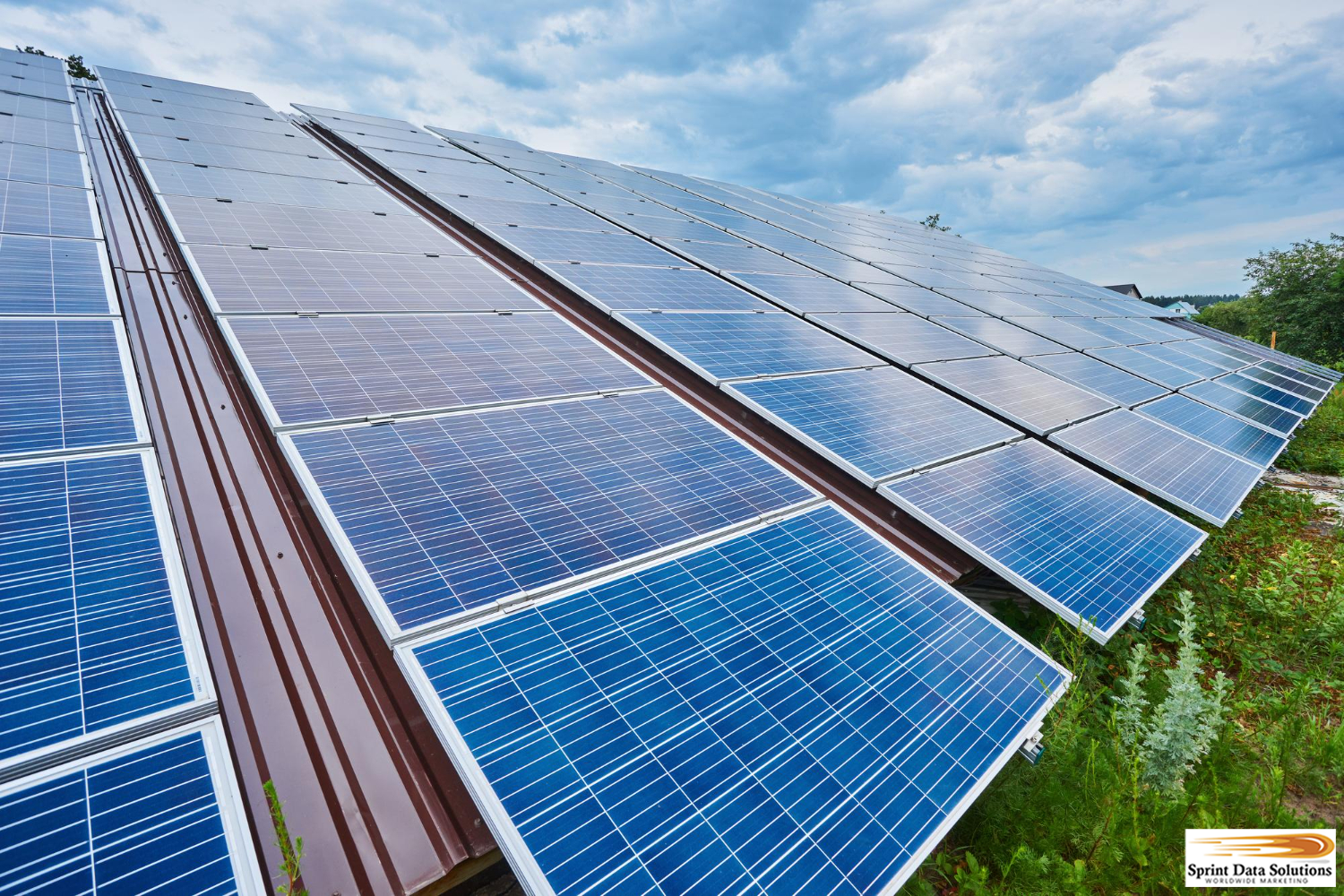Solar Power Is Generating More Leads Than Ever Before
Energy is the lifeblood of modern society, shaping everything from daily activities to global industries. Electricity, in particular, plays a fundamental role in every aspect of life in the United States, transforming how people live, work, and connect. It powers homes, schools, hospitals, businesses, and transportation systems, enabling virtually every task that sustains day-to-day life. The importance of electricity has led it to be considered a utility, not just a luxury. Its absence would disrupt everything from basic comfort—like lighting and refrigeration—to crucial functions in hospitals, where life-saving equipment relies on uninterrupted power.
The continuous flow of electricity is integral to modern business operations. Whether it’s running computers, communication networks, or automated manufacturing systems, electricity enables industries across the board to thrive. Without it, businesses would grind to a halt. The growing dependence on technology in all sectors has only increased the need for reliable energy sources that can support the digital age’s demands. Additionally, in today’s interconnected world, the ability to recharge mobile phones, laptops, and even electric cars has become an essential part of the modern lifestyle.
The evolution of electrical generation in the U.S. reflects the nation’s adaptability and ingenuity in meeting the increasing demand for energy. Early electrical systems were powered by coal, which dominated much of the industrial era, providing a steady and affordable source of electricity. Simultaneously, hydroelectric plants began to harness the power of flowing water, contributing to the rise of renewable energy. The discovery of nuclear energy marked a significant shift, as reactors provided large-scale, efficient power production, fueling the growth of the nation’s infrastructure. Each of these energy sources played a vital role in meeting the growing demand for power across the country.
However, as environmental concerns about fossil fuels grew, and the potential dangers of nuclear energy became more apparent, the search for alternative, cleaner energy sources accelerated. Wind and solar power have emerged as viable, renewable alternatives that offer both sustainability and a smaller carbon footprint. Today, the U.S. is at a crossroads in energy production, balancing the benefits of renewable sources like wind, solar, and geothermal with the need for consistent, reliable energy that meets the needs of businesses, households, and infrastructure. While research into nuclear fusion promises an exciting future, for now, wind and solar power lead the way in efforts to transition toward a more sustainable energy landscape.
Electricity generation continues to evolve as new technologies, such as battery storage systems and grid optimization, enable better integration of renewable energy into the national grid. As the U.S. embraces these new solutions, the push for greater energy efficiency and reduced environmental impact remains a driving force. The continued growth of electric vehicles, smart homes, and energy-efficient technologies signals a future where the energy landscape is not only diverse but also sustainable, ensuring that electricity remains a constant presence in the lives of Americans.

Coming Into Its Own
Solar power, a renewable energy source that harnesses the sun’s rays to generate electricity, has undergone a profound transformation over the years. The concept of solar energy isn’t new, and the technology for capturing sunlight and converting it into electricity has been in development for decades. In fact, even in the 1980s, solar cells, while not as efficient as today’s models, were already being used to power small electronic devices like calculators and watches. These early systems were based on relatively inefficient photovoltaic (PV) cells, which could only capture a small fraction of the energy from sunlight and convert it into electricity.
The idea of scaling solar energy production to meet more substantial power demands was an ambitious one. The first solar farms were enormous and required vast stretches of land to house the large arrays of panels necessary to generate even modest amounts of electricity. The solar fields were often located in remote, flat areas like the deserts of California, where the abundance of sunlight could be most effectively utilized. Some of the early solar plants even incorporated motorized mirrors or tracking systems designed to reflect additional sunlight onto the solar panels to maximize efficiency. These early systems, while groundbreaking, had significant limitations. The energy produced was still relatively small-scale, and the infrastructure needed to capture and store this energy was complex and expensive.
Over the past few decades, solar technology has evolved at an exponential pace. Advances in materials science and solar cell design have led to the development of much more efficient photovoltaic cells that can convert a higher percentage of sunlight into usable electrical energy. Today’s solar panels are not only more efficient but also more compact, meaning they can generate much more power per square foot. As a result, solar energy has become a more viable option for residential and commercial use. For example, a typical residential solar array on a home’s roof can now generate enough electricity to power the home’s entire energy needs, and in many cases, can even produce a surplus. This surplus energy can be fed back into the grid through net metering programs, allowing homeowners to receive credits or compensation for the excess electricity they contribute to the grid, which can reduce their energy bills or even generate a small income.
The benefits of solar power go beyond just financial incentives, though. As the world moves toward more sustainable energy solutions, the role of solar energy becomes increasingly crucial in reducing dependence on fossil fuels and mitigating the environmental impact of traditional power generation methods. Solar power is a clean, renewable resource that doesn’t emit harmful pollutants or greenhouse gases, making it a key player in the fight against climate change. Moreover, the scalability of solar power—from small rooftop systems to massive utility-scale solar farms—means it can be adopted by individuals, businesses, and governments alike, all contributing to a more sustainable energy future.
Another factor driving the increased interest in solar energy is the significant reduction in the cost of solar technology. Over the past decade, the price of solar panels has dropped dramatically, making solar power more affordable for the average consumer. Government incentives, rebates, and tax credits have further lowered the financial barriers to entry, enabling more people to install solar panels on their homes and businesses. As manufacturing processes have become more efficient and demand for solar technology has increased, economies of scale have led to even greater reductions in cost.
Today, the solar energy sector is thriving, with numerous innovations on the horizon. Advances in energy storage technologies, such as batteries, have made it possible to store excess solar energy for use during periods when sunlight isn’t available, such as at night or during cloudy weather. Additionally, new materials and designs, such as flexible solar panels and solar windows, are opening up new possibilities for integrating solar technology into everyday life, from portable devices to the very buildings we live and work in.
In summary, solar power has come a long way since its early days, and its role in our energy landscape has become more vital than ever. With continued technological advancements, the cost of solar energy will likely continue to drop, making it an even more accessible and attractive option for homeowners, businesses, and governments around the world. As the world faces the challenges of climate change and energy sustainability, solar energy stands out as a bright solution for a cleaner, greener future.
A Stable Alternative
One of the primary advantages of solar power over other forms of electrical generation is the consistency and reliability it provides, both in terms of energy production and economic stability. While renewable systems like wind and hydroelectric power can sometimes be unpredictable, solar panels stand out by offering more reliable energy output. Although they rely on sunlight, solar systems can still generate electricity on cloudy or rainy days, albeit at reduced efficiency compared to peak sunny conditions. This level of consistency makes solar a highly dependable source of energy for both residential and commercial properties, particularly in areas with fluctuating or unreliable weather conditions.
In addition to the technical reliability of solar power, it also provides significant economic stability. One of the biggest financial advantages of solar energy is the drastic reduction in dependency on conventional power grids. Solar-powered homes and businesses can often produce their own electricity, with the possibility of generating excess energy to be fed back into the grid. This excess electricity can be sold back, earning the property owner credits or payments in a system known as net metering. This self-sufficiency reduces reliance on fossil fuels, whose prices are vulnerable to volatility due to geopolitical tensions, tariffs, sanctions, or fluctuations in global markets. As energy prices for oil, natural gas, and coal are influenced by external factors such as international conflicts or market restructuring, solar energy helps protect property owners from these price hikes, ensuring long-term energy cost predictability and financial savings.
Furthermore, solar energy offers an unparalleled level of independence from traditional power sources. Unlike grid-powered electricity, which is susceptible to local power outages, solar-powered systems can operate independently during blackouts, especially when paired with energy storage solutions like batteries. This independence can be especially important for both residential homes and businesses, providing uninterrupted power in critical times. For instance, businesses can continue operations and maintain essential services, such as refrigeration, lighting, and security systems, even when the surrounding area experiences a power failure. This reliability is especially beneficial for industries that require constant power, such as healthcare, food storage, and manufacturing, where downtime can lead to severe operational and financial consequences. Furthermore, solar-powered systems do not require additional fuel sources, unlike traditional backup generators, which rely on gas, diesel, or other fuels. This makes solar power a cleaner, more sustainable, and cost-effective backup solution during emergencies.
Finally, the environmental benefits of solar power should not be overlooked. As an entirely clean, renewable source of energy, solar power reduces a property’s carbon footprint and dependence on fossil fuels. This not only benefits property owners by reducing their environmental impact but also aligns with global trends toward sustainability. As governments, businesses, and individuals place increasing importance on reducing carbon emissions and supporting renewable energy initiatives, solar power becomes an attractive investment for those looking to future-proof their energy needs while contributing to the fight against climate change.
In conclusion, solar power provides unparalleled stability across several key factors—technical reliability, economic independence, energy security, and environmental benefits. For homeowners and businesses, solar energy offers the dual advantages of reliable energy production and financial resilience, while providing independence from unpredictable power grids and the fluctuating prices of fossil fuels. These factors make solar power a compelling choice for those seeking both stability and sustainability in their energy solutions.
It’s Not Just Homes
While solar panels have been widely adopted by homeowners, their advantages extend far beyond residential properties. Businesses, in particular, stand to gain significantly from investing in solar power systems, as these upgrades can provide substantial long-term financial returns. The initial investment, though considerable, is often offset by the substantial savings on energy costs over time. Companies in various sectors can experience remarkable benefits, including reductions in electricity bills, tax incentives, and increased energy independence. Not only can this shift to solar energy help businesses lower their carbon footprints, but it also improves sustainability credentials, which are increasingly important to consumers and investors alike. Among the many types of businesses that can capitalize on solar energy are manufacturers, retail stores, warehouses, and offices, all of which can benefit from a more stable and predictable energy supply, often coupled with government rebates or subsidies to reduce installation costs.
Manufacturing
Businesses involved in manufacturing often possess two key characteristics that make them ideal candidates for harnessing solar power. First, manufacturing facilities typically feature large buildings with expansive roof spaces, which are often underutilized. These vast areas provide the perfect location for the installation of numerous solar panels, effectively transforming previously unused space into a powerful energy-generating asset. The second key factor is the high energy consumption inherent in manufacturing operations. These facilities require significant electricity for machinery, production lines, and climate control, making energy costs a major portion of overall expenses.
Though the initial investment in solar panels and the installation process may seem substantial, the long-term financial benefits quickly outweigh these costs. The solar power generated from a large roof installation can dramatically reduce a facility’s reliance on the local power grid. This reduction in external energy consumption directly leads to lower electricity bills, providing immediate savings. Over time, these savings compound, offering a substantial return on investment (ROI) and improving overall financial stability.
Moreover, the adoption of solar energy offers additional benefits, such as potential tax credits, incentives, and improved sustainability profiles. By integrating renewable energy solutions into their operations, manufacturers can not only lower their operational costs but also enhance their environmental responsibility. This dual advantage of cost reduction and sustainability can give businesses a competitive edge, improving their brand image while contributing positively to global efforts to combat climate change. In an era where energy costs are volatile and environmental concerns are rising, solar power offers a stable and forward-thinking solution for manufacturers looking to optimize their financial and operational efficiency.
Livestock
Farming and agriculture continue to play a vital role in the American economy, particularly in the livestock sector, where ensuring proper care and climate control for animals is essential. As operations scale up, the need for reliable and consistent power sources becomes more pronounced. In colder months, maintaining an optimal temperature in barns or other facilities housing livestock, such as poultry, can become a significant operational cost. This is especially true when the energy demand for heating is high, driving up electricity expenses.
Fortunately, the agriculture industry, much like manufacturing, can benefit from renewable energy sources like solar power. Large livestock facilities often have expansive roofs that are largely underutilized, making them prime candidates for solar panel installation. These large roof spaces can be equipped with solar panels to generate renewable energy that can significantly offset heating costs. Solar energy can power the heating systems needed to maintain a consistent environment for livestock, including egg-laying poultry, where temperature control is crucial for productivity.
By installing solar panels, farmers can drastically reduce their reliance on expensive grid electricity, and in turn, lower their overall energy bills. The upfront investment in solar energy can be quickly recouped through the substantial savings generated over time. Not only does this offer cost savings, but it also provides an environmentally friendly solution to energy consumption in agricultural operations. In addition, solar power systems can increase the long-term sustainability of a farming business, making it more resilient to fluctuating energy prices and less dependent on non-renewable resources. For larger livestock operations looking to optimize efficiency and reduce expenses, solar energy presents a compelling investment with the potential for both immediate and long-term financial benefits.
Commercial
It’s not just industries that can take advantage of solar power; many other businesses, particularly those in the white-collar sector such as technology, finance, and professional services, can also reap significant savings by transitioning to solar energy. Office buildings, for example, are heavy consumers of electricity due to the constant use of computers, servers, photocopiers, lighting, and HVAC systems. While the power needs of an office environment may not match the high-demand machinery found in manufacturing or production facilities, they are still a continuous drain on the electrical grid throughout the day. By installing solar panels on the roof or across business premises, companies can drastically cut their energy bills.
In some cases, especially for larger businesses with higher energy consumption, solar power can even eliminate the need for grid electricity altogether. With the right setup, a business can go fully off the grid, producing enough energy to meet all operational needs through solar energy alone. This not only lowers ongoing electricity costs but also helps businesses gain energy independence, reducing vulnerability to fluctuating energy prices and supply disruptions. Moreover, businesses that make the switch to solar energy often benefit from incentives, rebates, and tax credits, making the upfront installation costs more manageable while yielding substantial long-term savings.
Retail
Retail businesses, particularly larger establishments like shopping malls and big box retailers, often have high energy consumption due to the need to maintain lighting, security systems, climate control, and other operational needs. These businesses typically rely heavily on electricity to power everything from the extensive lighting required for large retail spaces to security systems such as surveillance cameras and anti-theft devices. This energy use becomes even more significant in large commercial properties that operate multiple services under one roof.
One underutilized resource for these businesses is the vast roof spaces that are often left unused, aside from their primary role in providing shelter. Installing solar panels on these roof spaces or other available parts of the property, such as parking lots or unused land, can significantly reduce energy dependence. Solar power systems offer the added advantage of providing a reliable, consistent energy source. As they generate power from the sun, which is often abundant and predictable, businesses can benefit from lower electricity bills over time and even move toward energy independence.
By implementing solar energy on a larger scale, retail businesses can either substantially reduce or even eliminate their electricity costs. In some cases, businesses may even generate more energy than they need, allowing them to sell surplus power back to the grid, further improving their bottom line. These savings can be especially beneficial in the long term, as they eliminate the volatility of fluctuating energy prices and transform energy costs into a predictable, fixed expense. The upfront cost of installing solar panels can be mitigated by long-term savings on energy bills, tax incentives, and the potential for government rebates, making it a smart investment that aligns with sustainability goals. Ultimately, incorporating solar energy systems not only enhances operational efficiency but also supports a business’s reputation for environmentally conscious practices, which can appeal to consumers who prioritize sustainability.

Residential
Solar power generation has proven to be a game-changer for homeowners, offering significant advantages, particularly in private residential spaces. One of the most compelling reasons for the increasing adoption of solar energy is the highly variable cost of electricity, which can fluctuate widely depending on the region, time of day, and the specific pricing structure employed by local energy providers. For many homeowners, this variability introduces a great deal of uncertainty when it comes to monthly utility bills. The constant need to monitor usage patterns to avoid higher “peak hour” rates can be both stressful and inefficient, particularly for families with unpredictable energy consumption.
By harnessing the power of the sun, solar energy systems eliminate the need for homeowners to constantly adjust their habits based on time-of-day pricing. The solar panels generate electricity during the day, and with the integration of energy storage systems such as batteries, it becomes possible to store excess energy for nighttime use. This means that even after the sun goes down, homes can still draw on the stored electricity without relying on the grid. In fact, with sufficient battery capacity and solar panel installation, many homeowners can achieve a significant level of energy independence, reducing or even completely eliminating their reliance on traditional utility companies.
This shift not only provides long-term cost savings but also contributes to environmental sustainability, as solar power is a renewable, clean energy source. Additionally, with advancements in solar technology and battery storage, systems are becoming more efficient and affordable than ever before. Homeowners can now more easily take control of their energy usage, stabilize their monthly costs, and significantly reduce their carbon footprint.
Rural Residents
Solar power generation is an invaluable resource, especially for individuals and businesses located in rural or remote areas where access to reliable electrical grids can be limited or intermittent. While urban and municipal areas typically experience faster response times in the event of power outages, rural locations often face extended periods without power due to the complexities involved in locating and repairing outages. During these times, relying on the grid for energy becomes increasingly impractical, leaving homes and businesses vulnerable to disruptions that can last for hours or even days.
This is where solar power systems shine, offering a sustainable and reliable alternative to grid dependence. Solar panels can provide continuous electricity, ensuring that power remains available even when the grid goes down. For rural properties, especially those prone to environmental challenges like storms, wildfires, or other recurring natural disasters, solar energy offers a dependable solution for maintaining comfort and normalcy. By investing in solar energy, homeowners and businesses can achieve a degree of energy independence that reduces their reliance on external power sources and provides peace of mind during emergencies.
This growing need for reliable, off-grid power solutions presents a significant opportunity for businesses offering solar technologies. Sprint Data Solutions Worldwide Marketing, with its extensive database of targeted consumers, can help connect these businesses with the customers who need their products the most. By providing precise data-driven marketing strategies, Sprint Data Solutions can enable solar companies to reach the right audiences—those in high-risk areas—ensuring that they are positioned to address the specific needs of these consumers, while also offering tailored solutions to enhance energy independence and resilience in the face of grid instability.
Who Is Sprint Data Solutions Worldwide Marketing?
Sprint Data Solutions Worldwide Marketing is a dynamic, American-owned business that was founded in Las Vegas, Nevada, by a disabled veteran with a vision to create an enterprise that would not only drive economic growth but also deliver high-quality marketing solutions. The company’s deep-rooted commitment to customer satisfaction and quality service quickly set it apart, leading to steady growth over the years. Today, it proudly boasts a team with over 50 years of combined experience in the marketing industry, a testament to its longevity and expertise.
Initially, Sprint Data Solutions Worldwide Marketing focused exclusively on direct mail, leveraging this medium to refine its capabilities in database collection, management, and analytics. This early focus on data integrity and client-oriented service laid the foundation for the company’s future success. When the digital marketing landscape began to emerge, Sprint Data Solutions seamlessly transitioned into this space, thanks to its solid foundation in data management. By integrating digital marketing strategies early on, the company gained a competitive edge that allowed it to offer its clients innovative solutions and impressive returns on investment.
As the demand for diversified marketing solutions grew, Sprint Data Solutions expanded its services beyond Nevada to a nationwide footprint, which later included Alaska and Hawaii. This expansion was driven by a commitment to delivering superior marketing services that met the evolving needs of businesses across the United States. Capitalizing on its growing reputation, the company began offering services to international markets, first with Canada and Mexico, and eventually extending its reach to the European Union, where markets like France were integrated into the company’s vast network.
Today, Sprint Data Solutions Worldwide Marketing has become a global leader in data-driven marketing, providing clients with an unmatched level of expertise and access to a comprehensive suite of services, including direct mail, digital marketing, and precise targeting of international markets. Through its dedication to continual growth and client success, the company has expanded its offerings to meet the diverse needs of businesses across different sectors, empowering clients to reach their target audiences with precision and impact across borders.

How We Can Help
Sprint Data Solutions Worldwide Marketing has dedicated years to the creation of an expansive and meticulously curated collection of contact databases, positioning itself as a leader in providing targeted and valuable marketing data. The company continually expands its reach through strategic partnerships with reputable data providers, ensuring that the range of contacts available is both diverse and comprehensive. The acquisition of this data follows a strict ethical and legal framework, ensuring full compliance with industry regulations. Sprint Data Solutions Worldwide Marketing gathers contact information through a variety of legitimate and transparent means, such as opt-in programs for newsletters, customer account sign-ups, subscription to services, completion of surveys, and the donation of business cards by individuals and organizations. This proactive and ethical approach not only helps grow the database but also fosters trust and ensures the integrity of the collected data.
What truly sets Sprint Data Solutions Worldwide Marketing apart is its commitment to treating its databases as dynamic, evolving assets rather than static records. The company prioritizes constant data maintenance, rechecking, and updating to guarantee that contact information remains accurate and timely. This ongoing reassessment allows the company to address inevitable changes in real-time—whether it’s a student’s graduation, an employee’s career shift, or unfortunate events like the passing of a senior. It is vital that the database accurately reflects these transitions to ensure the contact details provided to clients are as relevant as possible. Without this regular review process, the database would quickly lose its effectiveness, leading to wasted marketing efforts and client dissatisfaction. By ensuring the integrity of their records, Sprint Data Solutions Worldwide Marketing helps clients avoid sending materials to outdated addresses, deceased recipients, or disconnected individuals.
However, maintaining an extensive database is only one piece of the puzzle. Sprint Data Solutions Worldwide Marketing goes beyond simply offering access to a large pool of contacts. The company integrates advanced artificial intelligence (AI) systems to apply sophisticated data analytics and machine learning algorithms to the data. These AI tools enable the company to sift through vast amounts of information, organizing and categorizing it in ways that enhance its relevance. Rather than simply providing a generic list of names and addresses, Sprint Data Solutions Worldwide Marketing curates highly-targeted contact groups, filtered according to client-specific requirements. This precision targeting ensures that businesses receive access to the most qualified, responsive leads, increasing the likelihood of successful marketing campaigns. With the assistance of AI and data-driven insights, Sprint Data Solutions Worldwide Marketing is able to provide a level of sophistication in contact list segmentation that goes far beyond traditional methods, offering clients a higher return on investment and the ability to focus their efforts on the individuals most likely to engage with their products or services.
One of the key strengths of data-driven marketing is its ability to target audiences on a variety of geographic scales, from nationwide campaigns to highly localized initiatives. On a national level, businesses can access contact information for individuals across the entire country, making it ideal for broad-reaching campaigns aimed at a wide demographic. However, if a more tailored approach is preferred, marketers can narrow down their focus to specific regions, states, or even cities, enabling them to direct their efforts toward areas where they anticipate the highest potential for engagement. For example, targeting a specific area like New England can help businesses concentrate their resources on a geographically relevant audience. Furthermore, marketers can zoom in even further, honing in on a particular state, such as Massachusetts, or a city, such as Boston. Even finer targeting is possible by focusing on specific neighborhoods, like Beacon Hill, Boston, which allows businesses to address the unique preferences and needs of that smaller community.
Another critical component is the ability to segment audiences based on demographic and psychographic characteristics. The more refined the data, the more personalized and effective the marketing effort. Ethnic segmentation is especially valuable when marketing products or services that may appeal more to specific cultural groups, such as Latin Americans or those with particular religious affiliations like Catholics. By understanding the cultural nuances and preferences within these communities, businesses can craft campaigns that resonate deeply with their target audience. In addition to ethnicity and faith-based segmentation, businesses can also benefit from targeting specific economic groups. High-net-worth individuals, for instance, may be more receptive to luxury goods or investment opportunities, and targeting such individuals can significantly enhance campaign relevance. Demographic factors such as age and health conditions also play an essential role. For example, targeting individuals diagnosed with diabetes or those within specific age brackets allows businesses to tailor products or services to address specific health concerns or lifestyle needs, driving higher engagement, conversions, and overall response rates.
By combining both geographic and demographic segmentation, businesses can create highly personalized marketing strategies that yield superior results. This approach ensures that every message reaches the right person at the right time, increasing the likelihood of success for any marketing campaign.
Database Formats & More
Sprint Data Solutions Worldwide Marketing is equipped to provide contact details in virtually any format that aligns with your marketing strategy. Whether you’re working with direct mail, digital marketing, telemarketing, or SMS/text messaging, we can supply the precise data you need to engage your target audience effectively. For direct mail campaigns, we offer comprehensive access to physical mailing addresses for both consumers and businesses, allowing you to send out postcards, catalogs, or promotional material directly. In the digital marketing space, we provide email addresses for both consumer and B2B outreach, with B2B contact information typically including key decision-makers at relevant companies. For telemarketing campaigns, we supply phone numbers, including residential numbers for consumer outreach and business-specific numbers, with the direct contact details of decision-makers for B2B campaigns. Additionally, we offer cellular phone numbers for SMS/text messaging marketing, allowing you to connect with your audience directly through their mobile devices.
We also offer specialized services tailored to clients who may lack experience in executing successful direct mail campaigns. Our turnkey direct mail solutions cover every phase of the process, from initial concept and design to printing, manufacturing, and final distribution. With this all-inclusive service, clients receive expert guidance and comprehensive support throughout, eliminating the need to source and manage multiple vendors for each stage of their marketing efforts.
If you’re looking to connect with customers or businesses involved in solar energy or related sectors, Sprint Data Solutions Worldwide Marketing is here to help. Whether you’re targeting consumers or industry professionals, we provide high-quality leads that can drive results for your solar energy campaigns, ensuring that your outreach reaches the right individuals or businesses. Contact us today to learn more about how we can help you access the best leads for your marketing initiatives.






